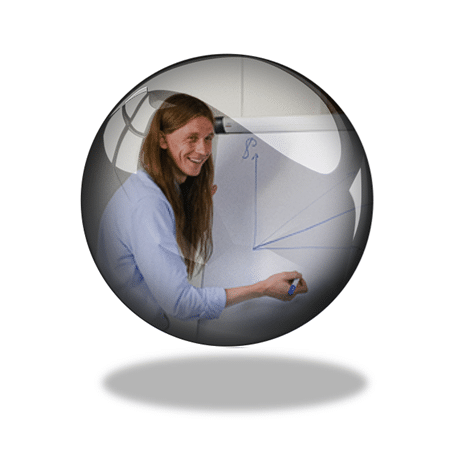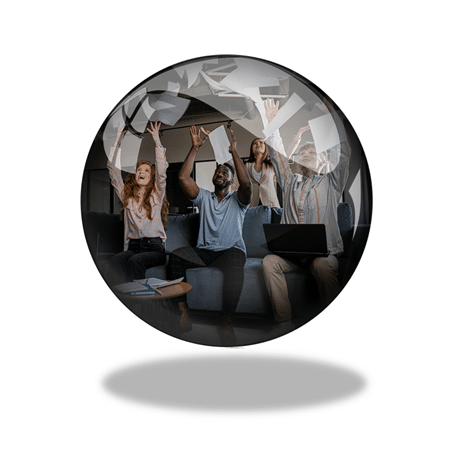Facilitation is a lot simpler than it appears, and a lot more powerful too. Furthermore it is the essential leadership practice in readying people for the new world of work.
– – – – – – – – – – – – – – – – – –
Facilitation is literally the act of making things easier. More commonly, it is about enabling a group of people to arrive at a desired outcome, efficiently and collectively. And to achieve this whilst remaining independent of that outcome.
process and intervention

This is achieved as a result of two things. It is about ensuring an effective process which people can follow, and it is about intervening to enable the people to better follow that process.
Good facilitation looks almost effortless because a well-designed process naturally picks up where the people are, and naturally aligns with where they need to go. As such, it appears to have a light touch, and provides an almost intuitive way forward.
Therefore, the real skill of facilitation lies in the process, and so it is somewhat ironic that many people tend to think of facilitators in terms of the ‘intervention’ side of their role.
Of course, there is no such thing as a perfect process, certainly not when dealing with people. No matter how well we have designed the initial process, it will go off-track if we do not carefully maintain its progress (and this is where the intervention comes in).
The purpose of facilitation
Facilitators are the custodians of ‘how’ things are being done. They are people who maintain their awareness in the meta-level of meeting and collaboration, observing the patterns that develop, comparing these against the process that was intended, and making small adjustments and interventions to keep things on track to a successful and valuable outcome.
four essentials of success

Key within this is maintaining the ‘four essentials of success’ at a functional level. These ‘four essentials’ are basic things that make the difference between success and failure for
any group (whether remote or physical). They are reflected in the following questions:
- Are people clear and in agreement about what they are trying to achieve in this activity? (Goals)
- Are they supportive of, and working in line with, an agreed and plausible approach to deliver that objective? (Process)
- Does everybody understand their role within that approach, and are they willing and able to effect that role? (Roles)
- Is the communication that is taking place constructive, supportive, and likely to encourage progress? (Interpersonals)
These are the questions that the facilitator needs to hold at the front of their mind at all times. If the answer to all four is ‘yes’ then the facilitator can feel confident that the group is making effective progress toward the desired outcome.
good questions lie at the heart of facilitation
However, if the answer to any of the four is ‘no’, then the facilitator needs to intervene in some way, either by instigating a change of process, or by addressing or highlighting the behaviour or issue that is the source of the problem. We can achieve this by posing a question to the group. A question is a beautiful thing, because it is both intervention and process.
Process

Questions also illustrate that ‘process’ does not need to be heavily structured. A process can be as simple as a single question, or a series of questions. In fact, many of the tools and templates we use in group facilitation are simply a reflection of different questions laid out in a logical pattern. And best practice for writing meeting agenda items is to phrase them as questions.
A key skill in facilitation is finding the right questions. Both in preparing the session beforehand, and in responding to things going ‘off-track’ in the moment.
At one level, the process can be as simple as posing the four bullet point questions above to the group. But it can also be as sophisticated as the whiteboard process for an organisation design sprint illustrated on the right.
the right tool for the right job

In between these two extremes lies a whole raft of proven tools and best practices – both complete processes, and bits of process – which equip the facilitator to shape the flow of the discussion to a meaningful outcome. Some of the tools are largely auditory, such as clean language and appreciative enquiry. And, some are largely visual, such as matrices and templates.
As with any master craftsman, the facilitator’s effectiveness is influenced by the range of tools at their disposal, and the skill they develop in using them.
Each of the four essentials of success:
Goals,
Roles,
Interpersonals and
Process (or GRIP if you like) is served by a different range of tools or process elements. You can see a sample of some of these by clicking on the links in the previous sentence. All of these elements are free to use from
Meeting Toolchest, and most can be used in physical or virtual environments.
Intervention
However, even when we are utilising an optimal process for what the group needs to do, problems can still occur. Progress can be hampered, or derailed, through behaviour, attitude or confusion. In these cases, the facilitator may need to intervene to bring things back on track.
The skill in these interventions lies in picking an option that is sufficiently strong to bring about the necessary correction, but not so strong that it is overly disruptive.
Non verbals
Non verbals are the gentlest form of intervention. They are most useful when a simple reminder that you are ‘present’ is enough for people to self-correct.
Examples may be shifting your posture, changing your location or expression, clearing your throat. Anything that indicates you may be about to intervene. Because, often, that is all that is required for people to think about why you might. And to give pause as to whether it might be because of them. And to momentarily reflect on what they personally are doing, and whether it is helping.
Furthermore, even if the individual misses the cue, someone else in the group may take responsibility for gently adjusting things, or redirecting the group’s attention.
helping people facilitate themselves
Other examples may include gently tapping someone on the shoulder, giving them a ‘look’, or standing behind them. This can help control side-conversations. For those dominating the dialogue, it can include gestures, indicating brevity or toning it down a bit. And gestures to highlight something in the room, for example a ground rule or an objective, can also help.
But please be aware, the effectiveness of non-verbals is very dependent on your relationship with the group. Particularly your consistency, your credibility, and the respect they have for your motivation.
Direct interventions

However, often the issue is beyond the scope of intuitive self-correction by individuals or the group. In this case you may need to explicitly interrupt what is happening.
As was stated earlier, this is most effective in the form of a question. And it is likely to be aimed at getting the group to reflect on whichever of the essentials is currently awry. But if the group has got itself engrossed in a bit of an argument, or emotions are beginning to flow, you may need to get them to stop, and pause, or take a time out before you pose the question.
lift their thinking up a level
Sometimes a simple ‘So, what is happening here?’ or ‘So, where might we be going of track?’ is enough to provoke constructive self-reflection by the group. But sometimes it might be up to you to name what is happening, and to suggest how they correct it.
The most common issue that requires direct intervention concerns listening. Feeling listened to is key to achieving consensus in the group. But as the discussion gets more ‘enthusiastic’ people focus on what they want to say. This blocks them listening attentively to others, except to find a gap they can speak into. For help on this you might look at
Meaningful Conversation, and
Techniques to Advance Listening and Shared Understanding.
Facilitation Skills
The best source of skill development is using the tools and interventions for real. However, as illustrated in our
case study, this is unlikely to happen if potential facilitators do not get a good basic grounding in facilitation from the outset. And this basic grounding is best delivered by a training programme. Or, to be more technically accurate, a facilitated learning programme.
Such programmes enable people to learn, practice and develop the confidence they need to lead in this way. In them, they will equip themselves with a range of process elements and interventions. And they will learn to combine them and adapt them to achieve everything they need. These programmes provide surety that people can facilitate adequately. And they provide enough experience, confidence and understanding to make them want to.
the master craftsman
But that is when the real learning, and enjoyment, begins. That is when people develop from an adequate facilitator to a craftsman in the art of facilitation. When they learn to fashion their own tools and style, and enjoy customising them to different situations. This is when they truly begin to enjoy leadership as a means to empower and grow others. And when they take real pride in the processes and practices they use to do this.
Share this on Linkedin – | Follow Culturistics insights on Linkedin –
Relevant Links:

 Key within this is maintaining the ‘four essentials of success’ at a functional level. These ‘four essentials’ are basic things that make the difference between success and failure for any group (whether remote or physical). They are reflected in the following questions:
Key within this is maintaining the ‘four essentials of success’ at a functional level. These ‘four essentials’ are basic things that make the difference between success and failure for any group (whether remote or physical). They are reflected in the following questions:
 In between these two extremes lies a whole raft of proven tools and best practices – both complete processes, and bits of process – which equip the facilitator to shape the flow of the discussion to a meaningful outcome. Some of the tools are largely auditory, such as clean language and appreciative enquiry. And, some are largely visual, such as matrices and templates.
In between these two extremes lies a whole raft of proven tools and best practices – both complete processes, and bits of process – which equip the facilitator to shape the flow of the discussion to a meaningful outcome. Some of the tools are largely auditory, such as clean language and appreciative enquiry. And, some are largely visual, such as matrices and templates. However, often the issue is beyond the scope of intuitive self-correction by individuals or the group. In this case you may need to explicitly interrupt what is happening.
However, often the issue is beyond the scope of intuitive self-correction by individuals or the group. In this case you may need to explicitly interrupt what is happening.


 Case Study: How client-driven development led to effective facilitation skills training for leaders, for customer success, and for hybrid working.
Case Study: How client-driven development led to effective facilitation skills training for leaders, for customer success, and for hybrid working. He went on to explain that, he had been reviewing his next level of senior managers. Wherein, he identified that there was still a strong tendency to be directive and autocratic. Particularly when under pressure. And he had realised that much of this was to do with a lack of awareness, skills, and confidence in practical alternatives. Alternatives that he himself had found through the facilitation training he had received two decades earlier. Training that had changed his approach and his career.
He went on to explain that, he had been reviewing his next level of senior managers. Wherein, he identified that there was still a strong tendency to be directive and autocratic. Particularly when under pressure. And he had realised that much of this was to do with a lack of awareness, skills, and confidence in practical alternatives. Alternatives that he himself had found through the facilitation training he had received two decades earlier. Training that had changed his approach and his career. And the reaction of the candidates was better than we could have hoped. We used a scoring scale where 4 represents ‘expectations completely fulfilled’ and 5 represents ‘expectations exceeded’. The course averaged 4.6 across the 12 participants and over seven criteria.
And the reaction of the candidates was better than we could have hoped. We used a scoring scale where 4 represents ‘expectations completely fulfilled’ and 5 represents ‘expectations exceeded’. The course averaged 4.6 across the 12 participants and over seven criteria. Of course, the Customer Success professional has no authority within the customer space, so their success depends on constructing questions and debates that enable their customer’s leadership to self-discover a change management strategy which will most rapidly deliver the results they both want. And facilitation is the core skill in enabling this to happen.
Of course, the Customer Success professional has no authority within the customer space, so their success depends on constructing questions and debates that enable their customer’s leadership to self-discover a change management strategy which will most rapidly deliver the results they both want. And facilitation is the core skill in enabling this to happen. However, a new environment brings new possibilities, and successive lockdowns have meant that there has been a much greater take up and use of online meetings and virtual collaboration software. It has also provided a greater challenge in ensuring engagement of people at a distance. And it has opened up new ways of thinking about working in this way: better global partnerships; wfh and hybrid working; digital nomads; …
However, a new environment brings new possibilities, and successive lockdowns have meant that there has been a much greater take up and use of online meetings and virtual collaboration software. It has also provided a greater challenge in ensuring engagement of people at a distance. And it has opened up new ways of thinking about working in this way: better global partnerships; wfh and hybrid working; digital nomads; … Using best-practice online facilitative approaches, participants are more absorbed and stimulated than they commonly experience, even in physical meetings. As a result it avoids the fatigue and disengagement typical of virtual meetings. Because of this, we can deliver it in full day, which makes it more efficient and easier to schedule into peoples calendars.
Using best-practice online facilitative approaches, participants are more absorbed and stimulated than they commonly experience, even in physical meetings. As a result it avoids the fatigue and disengagement typical of virtual meetings. Because of this, we can deliver it in full day, which makes it more efficient and easier to schedule into peoples calendars.
 And whereas a healthy team can inspire and amplify everyone’s efforts, an unhealthy team can do entirely the opposite. And in doing so, it can create disabling levels of anxiety and depression. We were all built for relationship, and when we are denied the opportunity to ‘belong’ in this way it can have harmful effects on us. It can strip us of enthusiasm, self-belief, confidence, mental wellbeing, even hope.
And whereas a healthy team can inspire and amplify everyone’s efforts, an unhealthy team can do entirely the opposite. And in doing so, it can create disabling levels of anxiety and depression. We were all built for relationship, and when we are denied the opportunity to ‘belong’ in this way it can have harmful effects on us. It can strip us of enthusiasm, self-belief, confidence, mental wellbeing, even hope. Oftentimes they are the result of unresolved
Oftentimes they are the result of unresolved 
 And the shift in our thinking makes it much more likely that we will tend toward the closed dialogue responses on the red side of the diagram above.
And the shift in our thinking makes it much more likely that we will tend toward the closed dialogue responses on the red side of the diagram above.












